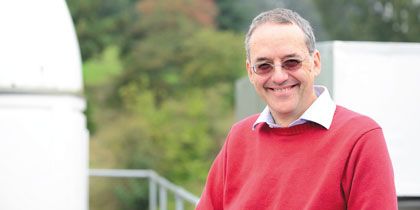
December 16, 2016, by Lindsay Brooke
Consensus is not a dirty word
This blog by Michael Merrifield, Professor of Astronomy in the School of Physics and Astronomy at The University of Nottingham, has been given extra poignancy by recent comments from the Trump transition team.
Science is, by its very nature, a collective activity
“If it’s consensus, it isn’t science.” This quote from a speech by Michael Crichton was thrown at me in a recent discussion of climate change in refutation of the significance of the broad agreement among the scientific community that human activity is screwing up the climate. Mr Crichton had a background in medicine and research before rising to fame for his novels, but this assertion lies firmly in the realm of science fiction rather than science fact.
Science is, by its very nature, a collective activity, with a complex network of people working on interlinked problems, sometimes in direct collaboration, but also drawing on each other’s results to spark new ideas. Without a common framework for this evolving knowledge, progress would be completely impossible, as we would not even have a shared language through which to understand each other. This narrative forms the basis of the consensus of which Mr Crichton was so dismissive.
Of course, that consensus can be wrong. In my own field of astronomy, until the 1990s it was generally held that the Universe’s expansion due to the explosion of the Big Bang was being slowed by the influence of gravity trying to pull all the mass back together. However, new observations turned up the unexpected result that, far from slowing down, the expansion of the Universe seems to be accelerating with time, and we had to revise our views and come up with a physical mechanism, “dark energy,” to explain this phenomenon.
In his 1962 book The Structure of Scientific Revolution, the physicist and philosopher Thomas Kuhn coined the term “paradigm shift” to describe such step changes in scientific understanding. Note, however, that far from not being science, consensus forms a vital element in this process: it is the “null hypothesis” that those arguing for such change seek to test to destruction, and provides the benchmark against which any new World view must be shown to be an improvement.
Perhaps a useful way to visualise scientific progress is to imagine an abstract set of parameters that we can vary, from which we can derive some measure of how well a particular set of ideas describes the phenomenon under scrutiny. If there were two such parameters, one can think of them as describing coordinates on a map, with the success of the explanation being analogous to the height above sea level of that particular location.
The scientific process involves seeking the best explanation, which means finding the “highest peak” on this map. As a scientist wandering around in this strange landscape, one approach to trying to find this highest peak is to simply keep walking steadily up hill, since that is clearly improving the explanation. However, eventually you will reach the top of this local hill, and then be stuck, with no way of knowing whether there are other higher peaks, or better scientific explanations, elsewhere on the map.
This problem of getting stuck at a local maximum is a well-known issue in optimisation theory, and one of the techniques developed to overcome it is a process called “simulated annealing.” This method involves generally travelling up hill, but occasionally heading off in a random direction to explore away from the local peak to see if there are other undiscovered higher points elsewhere in the landscape. Clearly, a balance is required between these two processes: too few random jumps, and there is a danger of getting stuck for a long period on a local peak; too many random jumps, and one wastes a lot of effort on tests the vast majority of which will be failures. Simulated annealing seeks to optimise this process by making more larger random leaps early in the process to map out the landscape, but then focusing more on the trudge up hill to close in on the ultimate solution (though always with the occasional random jump as a “sanity check”).
Hopefully, the analogy with the broader scientific process is clear. The steady march up-hill represents a general consensus developing slowly from where it is, while the occasional random jump is the contribution of the contrarians who explore completely different ideas to see if they work better than the consensus. As with simulated annealing, both elements are vital to the success of science: the consensus keeps progress moving along, while the iconoclasts provide a sanity check and help precipitate the very occasional paradigm shifts that takes our understanding to an entirely new level. By their nature, most of these random leaps will prove fruitless, but that does not make them any less important to the process. Equally, however, anyone saying that consensus isn’t science misunderstands how science works. And creating the “false balance” of giving equal weight to the consensus and contrarian view fundamentally fails to grasp their different roles: while it can certainly be the case that a mature consensus is found to be wrong, it usually isn’t.
No comments yet, fill out a comment to be the first

Leave a Reply